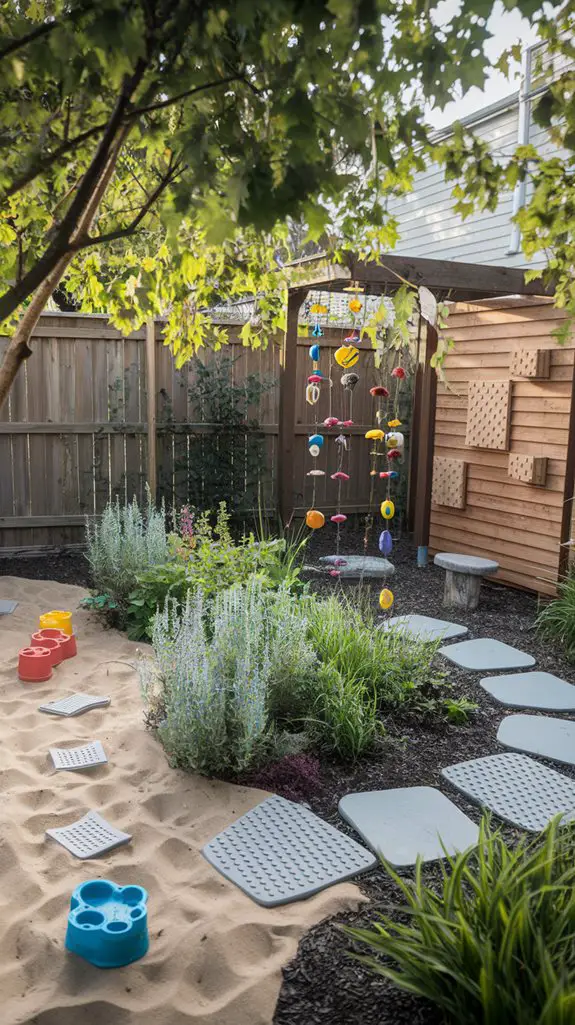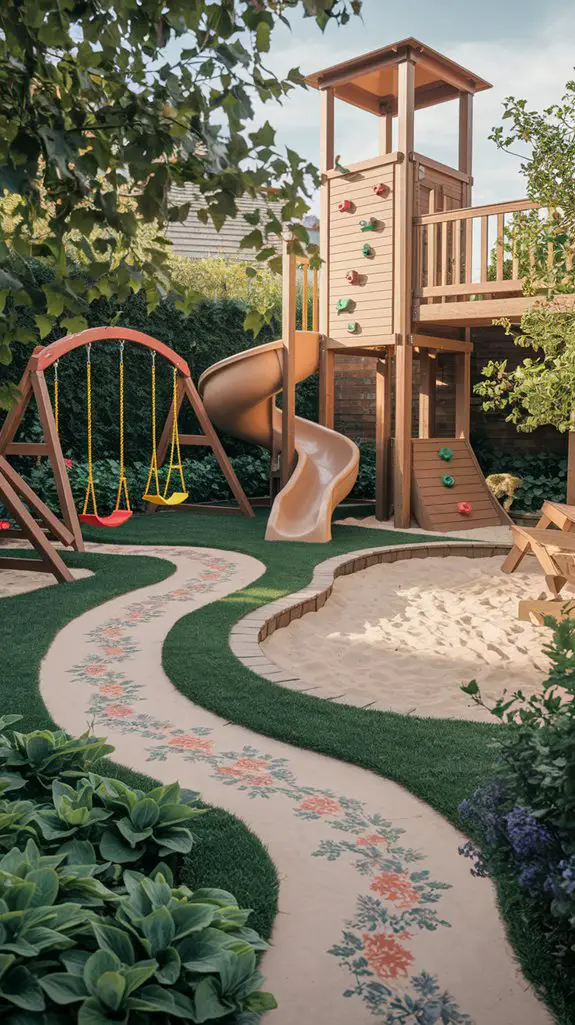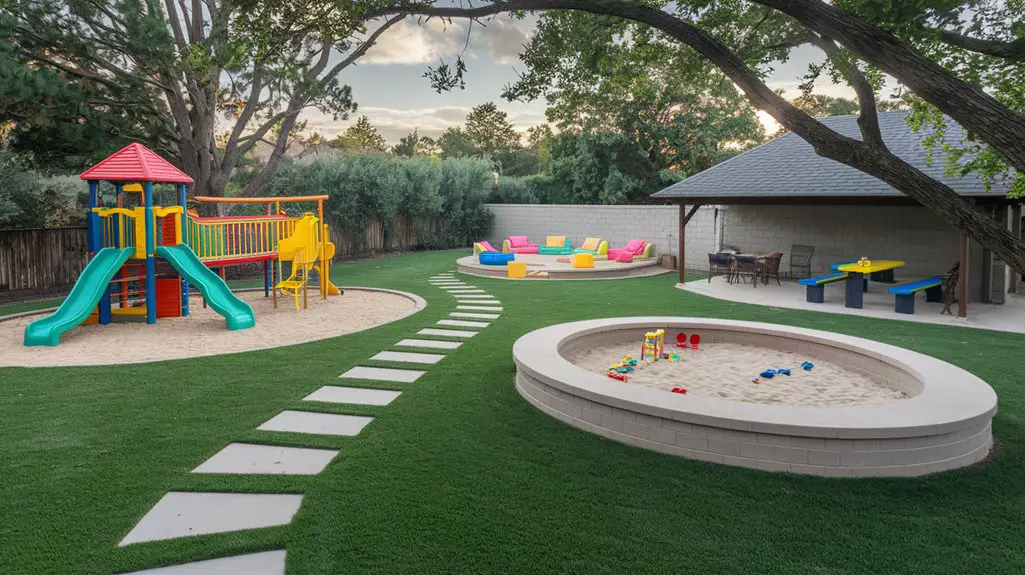Your backyard doesn’t have to split your family into age-specific zones. You’ll discover that thoughtfully designed play spaces can unite toddlers, tweens, and teens in shared experiences while addressing their distinct developmental needs. From adjustable climbing challenges to sensory exploration areas, the right elements create an inclusive outdoor environment that evolves as your children grow. These seven ideas will transform your ordinary yard into a multi-generational playground where everyone finds their place.
Design a Modular Playground System With Adjustable Challenges
When creating a backyard that serves children of various ages, a modular playground system offers the most versatile solution.
Select components that can be reconfigured as children grow, featuring adjustable heights for climbing walls and interchangeable challenge levels.
Install a central platform with multiple attachment points for slides, cargo nets, and climbing ropes.
You’ll want to include removable handholds that can be repositioned to increase difficulty as children develop stronger grip strength and coordination.
Consider incorporating color-coded elements to designate difficulty levels—green for beginners, blue for intermediate, and red for advanced challenges.
This system allows siblings of different ages to play simultaneously while maintaining appropriate difficulty for each child’s developmental stage.
Create Sensory Exploration Zones for Different Developmental Stages

Sensory exploration zones, carefully designed by developmental stage, transform ordinary backyards into rich learning environments.
Install textured pathways using river rocks, wood chips, and sand to stimulate toddlers’ developing tactile senses. Position these materials in defined sections separated by low timber borders.
For preschoolers, create water exploration stations with adjustable water tables, simple pumps, and channels. Include musical elements like suspended pipes of varying lengths that produce different tones when struck.
School-aged children benefit from complex sensory challenges like scented herb gardens they can tend themselves.
Install weather stations with simple measuring instruments to engage their scientific curiosity. Additionally, incorporating creative DIY ideas can enhance the play area, making it more interactive and engaging for all ages.
Connect these zones with connecting spaces—pergolas draped with wind chimes or textured fabrics—allowing children to reset their sensory systems between activities.
This graduated approach guarantees all developmental stages receive appropriate sensory stimulation.
Install Multi-Level Play Structures With Something for Everyone

Multi-level play structures extend the sensory journey into three-dimensional space, offering interconnected challenges for children of all ages. When designing these versatile play hubs, incorporate graduated difficulty levels that naturally segment activities while maintaining visual connection between play zones.
Consider these strategic design elements:
- Lower platforms (12-24″ height) with wide, stable steps for toddlers, featuring manipulative panels and crawl-through tunnels.
- Mid-level zones (3-4′ height) with climbing nets and balance features that build coordination for elementary-aged children.
- Upper reaches (5-7′ height) with challenging climbing walls, zip lines, or rope courses that satisfy teens’ need for advanced physical challenges.
Use connective elements like tube slides that span multiple levels, allowing children to shift between age-appropriate zones while siblings maintain proximity despite different skill levels. Incorporating backyard playground equipment for toddlers will enhance safety and engagement for younger children.
Incorporate Natural Play Elements That Grow With Your Children
Natural play elements transform the trajectory of childhood development by adapting organically to growing capabilities and interests.
Install boulder clusters that serve as toddler climbing challenges, then become parkour courses for teens.
Plant willow tunnels that create magical crawling spaces for young children and later provide secluded reading nooks for older kids.
Consider a dry creek bed with stepping stones—simple balance practice for little ones transforms into a complex obstacle course as children grow.
Large logs function as balance beams initially, then become imaginative play props or outdoor seating for adolescents.
Design an edible garden with varying responsibilities: preschoolers can water, elementary children can harvest, and teenagers can plan seasonal plantings.
These natural elements evolve with minimal modification while supporting different developmental stages simultaneously. Additionally, incorporating pet-friendly features into your yard can enhance the overall play experience for children and their furry companions.
Set Up Versatile Sports and Activity Areas for All Ages
Designing adaptable recreational zones requires thoughtful planning that accommodates various skill levels within a single space.
Install adjustable equipment that serves multiple age groups simultaneously, such as basketball hoops with height-adjustment mechanisms or convertible net systems for volleyball, badminton, and tennis.
- Create a multi-use court with removable boundary markers and interchangeable goals that transform the space from soccer to hockey to kickball in minutes.
- Install playground surfacing with painted game templates (hopscotch, four-square, target throws) that appeal to different developmental stages.
- Designate a flexible fitness zone with age-appropriate challenge stations—simple balance beams for toddlers alongside parallel bars for older children.
Consider foldable or storable components that maximize your available square footage while providing diverse activity options throughout different seasons.
Establish Collaborative Building and Creative Spaces
Create a dedicated construction zone with large wood blocks, interlocking plastic bricks, and recycled materials that both toddlers and teens can manipulate.
Install a 4’x8′ weatherproof workbench with varied height sections so younger children can stand while older ones sit on stools.
Add storage bins labeled with images and words to encourage organization across literacy levels.
Consider a covered sandbox with built-in shade that converts to a mud kitchen, featuring removable bowls and utensils scaled for different hand sizes.
Position these creative spaces adjacent to seating where adults can supervise without interfering, allowing cross-age mentoring to flourish naturally during cooperative projects. Additionally, incorporating safe play materials can enhance the tactile experience and ensure that children of all ages can enjoy the space together.
Include Quiet Retreat Areas for Independent Play and Relaxation
Every backyard play area needs designated quiet zones where children can retreat from high-energy activities and enjoy moments of solitude or small-group connection.
These calming spaces provide essential balance and accommodate different personality types and energy levels.
Create effective retreat areas by incorporating:
- Weather-resistant canopies or small playhouses positioned away from high-traffic zones, ideally with natural shade
- Child-sized seating options like stumps, cushions, or hammocks paired with book storage in weatherproof containers
- Sensory elements such as wind chimes, bubble stations, or small water features that provide gentle stimulation
Position these quiet zones with clear sightlines for adult supervision while maintaining enough separation from louder play spaces to create a genuinely peaceful atmosphere children can access when they need downtime.
Conclusion
Your multi-age play paradise provides perfect potential for family fun and functional fitness. By designing deliberate spaces that shift and shape with your children’s changing capabilities, you’ve created a continuously compelling backyard. Remember to regularly refresh and reconfigure elements as your kids grow. With these purposeful, playful plans, your outdoor space will serve sensory, social, and strategic development for all ages simultaneously.




